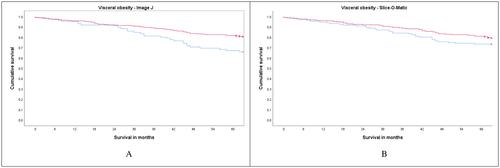The relationship between computed tomography-derived body composition and survival in colorectal cancer: the effect of image software
Abstract
Background
In the literature, there is considerable variation of the proportion of patients reported as having a low skeletal muscle index (SMI) (sarcopenia) or skeletal muscle radiodensity (SMD) (myosteatosis). The aim of the present study was to compare two commonly used software packages, one manual and one semi-automated to quantify body composition of patients with colorectal cancer.
Methods
The study included 341 patients with colorectal cancer. ImageJ and Slice-O-Matic were used to quantify the computed tomography images for total fat index, visceral obesity (visceral fat index, VFI), high subcutaneous fat index (SFI), sarcopenia (SMI), and myosteatosis (SMD). Bland–Altman analysis was conducted to test agreement of the two software programs for these indices. Survival analysis was carried out using previously defined thresholds and Cox regression.
Results
In Bland–Altman analysis, ImageJ gave consistently higher values for all body composition parameters (P < 0.001), resulting in more patients classified as high SFI (P < 0.001) and high VFI (P < 0.001) and fewer patients being classified as low SMI (P < 0.0001) and SMD (P < 0.001). The difference between SFI calculated using ImageJ and Slice-O-Matic was +7.9%. The difference between VFI, calculated using ImageJ and Slice-O-Matic, was +20.3%. The difference between low SMI and SMDs, estimated using ImageJ and Slice-O-Matic, was +2.9% and +1.2%, respectively. SFI, VFI, SMI (Dolan), SMD (Dolan), SMI (Martin), and SMD (Martin) were significantly associated with shorter overall survival using ImageJ (all P < 0.05).
Conclusions
ImageJ when compared with Slice-O-Matic gave higher values of different body composition parameters, and this impacted on the number of patients classified according to defined thresholds and their relationship with survival.


 求助内容:
求助内容: 应助结果提醒方式:
应助结果提醒方式:


